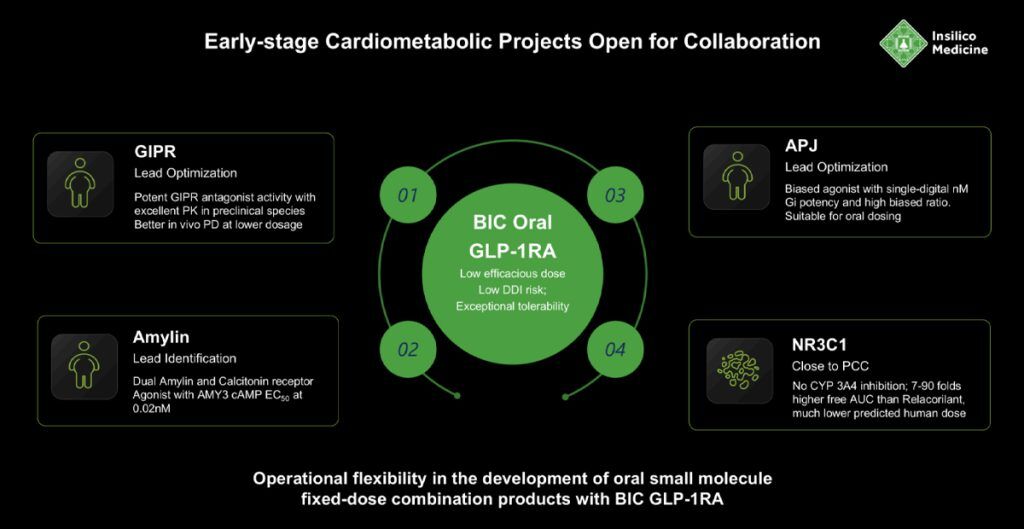Generative AI biotech unveils portfolio of novel cardiometabolic candidates aimed at tackling the biology of aging.
Insilico Medicine has announced a new wave of cardiometabolic programs discovered through its proprietary generative AI platform, Pharma.AI, positioning metabolic optimization as a cornerstone of longevity-focused medicine. Revealed at BIO-Europe 2025, the expanded portfolio includes eight oral small molecules designed to target established and moderately novel pathways involved in inflammation, insulin sensitivity and energy metabolism.
These include oral GLP-1 receptor agonists (GLP-1RAs) with improved safety and pharmacokinetics, a selective NLRP3 inhibitor for inflammatory and neurodegenerative disease, and candidates directed at NR3C1, GIPR, Amylin, APJ and Lp(a). The approach combines validated targets with novel chemical scaffolds to create compounds that could be used singly or in low-dose combination, a strategy designed to amplify effect while mitigating side effects.
“Cardiometabolic and antiobesity drugs such as GLP-1RAs may be the first wave of longevity therapeutics increasing both healthspan and lifespan in a large population,” said Alex Zhavoronkov, PhD, founder and CEO of Insilico Medicine.
“With our cardiometabolic strategy we decided to choose several established and moderate-novelty targets but deliver a high level of differentiation through novelty in chemistry focusing on properties to help unlock the full potential of the targets in a variety of diseases and biologic processes and allow for combinations at low dose.”
Longevity.Technology: Cardiometabolic disease has always been the silent saboteur of healthspan; it creeps in early, ages us from the inside out and – if left unchecked – undermines almost every aspect of longevity. That Insilico has chosen to focus its AI-driven firepower on this front is not just commercially astute, it’s strategically aligned with where the field is heading. As much as we all dream of cellular reprogramming and senolytic cocktails, the first generation of truly population-scale longevity drugs may not emerge from moonshot gerotherapeutics, but from metabolic optimization – targets like GLP-1, GIPR and NLRP3 that sit at the crossroads of inflammation, energy balance and aging biology.
What’s compelling here is the shift from narrow weight-loss framing to system-wide resilience: the notion that AI can design small molecules to fine-tune metabolism safely, at low doses, and potentially in combination. If these candidates deliver on their preclinical promise, Insilico’s approach could help reclassify metabolic disease as the entry point for applied longevity medicine rather than its afterthought. Still, translating AI-generated chemistry into durable clinical outcomes is where hype usually meets human biology; the coming years will show whether generative models can do more than accelerate discovery – whether they can also sustain healthspan.
AI as a catalyst for cardiometabolic innovation
Insilico’s announcement demonstrates its belief that AI has matured from a tool for target prediction into a full discovery engine. The company’s cardiometabolic pipeline spans seven biological targets and multiple therapeutic stages, from early discovery through to IND-enabling studies. Notably, two oral GLP-1RAs – one engineered for daily dosing and another for once-weekly administration – have reached or are nearing preclinical candidate stage.
Other highlights include a selective NR3C1 antagonist showing strong in vivo efficacy in reversing cortisol-induced metabolic dysfunction, and ISM8969, a brain-penetrant NLRP3 inhibitor designed to address inflammatory and central nervous system disorders. Insilico reports that its AI models have enabled the design of these candidates with high receptor selectivity, low metabolic clearance and favorable safety profiles, accelerating preclinical progress.

“The AI revolution in drug discovery is no longer theoretical, as demonstrated by our clinical-stage programs in fibrosis, oncology, and inflammation,” said Feng Ren, PhD, Co-CEO and Chief Scientific Officer of Insilico Medicine. “By harnessing our proven generative AI platform to address the complexity of cardiometabolic disease, we are committed to accelerating the discovery and development of differentiated therapies that will benefit millions of patients worldwide and help people live longer and healthier.”
From discovery to delivery
Insilico’s pipeline now includes 22 preclinical candidates, with the company reporting that AI-driven optimization has compressed discovery timelines from several years to around 12–18 months per program. Such speed, paired with the relatively low cost of oral small-molecule drugs, could make cardiometabolic longevity therapeutics scalable beyond niche markets.
Its clinical-stage portfolio already includes Rentosertib, the first AI-discovered novel-mechanism antifibrotic drug, which has completed Phase IIa trials with positive safety signals. Meanwhile, the company’s PHD1/2 inhibitor ISM5411, designed for inflammatory bowel disease, has completed two Phase I studies and shown a gut-restricted pharmacokinetic profile.
Metabolic momentum
Cardiometabolic pathways have become a focal point for biotech innovation in longevity, propelled in part by the success of GLP-1-based drugs. Yet where existing therapies tend to target single endpoints such as weight loss or glucose control, Insilico’s model proposes multi-target, multi-parameter optimization – an approach that reflects the interconnected biology of aging.
If AI can deliver molecules that modulate several hallmarks simultaneously – inflammation, mitochondrial decline, metabolic dysregulation – the boundary between disease treatment and prevention begins to blur. That, perhaps, is where true longevity medicine will take root: in the translation of everyday metabolic management into measurable extensions of healthspan.
These advances are supported by an unusually strong publication record. Since 2024, Insilico has published multiple papers across the Nature portfolio, documenting both algorithmic development and experimental data – a transparency that adds weight to claims of reproducibility and scientific validity in AI-enabled discovery.
A future shaped by algorithms and biology
Insilico’s announcement is not simply another entry in the AI-for-drug-discovery narrative; it signals a maturing landscape in which computational design and human insight are beginning to converge. As cardiometabolic resilience moves center stage in the longevity conversation, the question will no longer be whether AI can generate viable drug candidates – it will be whether those candidates can shift the baseline of aging itself.

